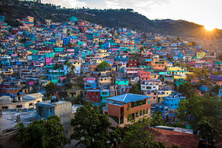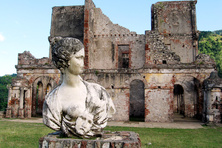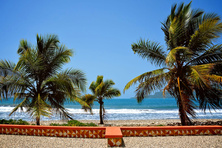Haiti
- Capital:Port-au-Prince
- Currency: Haitian gourde
- Time: UTC-5
- Languages: Haitian Creole and French
- Religions: Christianity (Catholicism, Protestantism)
- Sections: Get in Visa Customs Cuisine Money Details of interest Popular resorts
Haiti or officially the Republic of Haiti is the poorest country in America. It is situated on the west of the Hispaniola Island and occupies some other islands. On the east, it borders the Dominican Republic. Haiti is washed by the Atlantic Ocean on the north and by the Caribbean Sea on the south. The capital city is Port-au-Prince.
Haiti has a tropical climate with trade winds. The wet season is from April to June and from September to November. The rest of the year, the weather is dry and warm. European winter months are the best time for traveling to Haiti.
The official languages are French and Creole. Almost 80% of the population are the Catholics. According to non-official statistics, 70% of the Haitians also practice syncretic Voodoo cult.
Head to the Isabela Island to spend time on a beach, go yachting and sailing. The tourists can also try horse riding along the coastline. In the capital city Port-au-Prince, you can visit the natural reserves and parks and the beaches attract divers and surfers. A specialty of a trip to the capital city is voodoo rituals.
Get in
By Plane
There are no direct flights between CIS countries and Haiti. The tourists can take a transit flight with a stop in Havana, Santo Domingo, Kingston, Miami or New York. From the Haitian airports, there is only one flight to Paris offered by Air Caraïbes.
By Land
The regular trains run from the Dominican Republic to Haiti. The tourists can also cross the border in a car or on foot. From Santa Domingo, there is one bus to Port-au-Prince and Cap-Haitien.
Visa
The tourists from CIS and EU countries do need to obtain a visa to travel to Haiti provided that their stay in the country does not exceed three months. They will just need a valid international passport and a return ticket. The tourists will have to pay a border administration fee and have three passport-size photographs.
Customs
The travelers can bring in Haiti any sum of national and foreign currency. The sum exceeding 200 gourdes (or equivalent) must be declared.
The travelers can import the following goods duty-free:
- cigarettes and alcohol;
- perfume in a reasonable amount;
- personal belongings and other goods the total cost of which does not exceed 200 US dollars.
It is prohibited to import:
- fire arms (to bring in Haiti a sporting gun, one needs to obtain a permit from the consul-general of Haiti);
- coffee;
- pork and meat products from the Dominican Republic and Brazil;
- methyl alcohol;
- matches.
It is strictly prohibited to import in Haiti parrots. Other pets can be brought in the country provided that you have all the international standard vet certificates.
Cuisine
The Haitian cuisine is a mix of French, Creole and African influences. As the level of import of agricultural produce is high (87%), the local cuisine is not very rich in meat, eggs and fish. The staple foods in Haiti are millet, manioc, beans, rice and vegetables. Nevertheless, the Haitian cuisine is believed to be leading in the Caribbean region and this is due to the local chefs who can combine incongruous.
Try a meat dish La Bandera with roasted or boiled meat, rice, vegetables, beans and bananas.
Game is extremely popular in Haiti. We recommend grilled partridge with rice and sour sauce. For a side dish, the Haitians usually serve rice, pea, cereals and fried bananas. Sweet yams often substitutes bread in Haiti.
The foodies should try a local specialty – a fish Poisson marinated in lemon juice and roasted over the laurel or dill. One more exotic dish is roasted lobster Langust flambe, roasted swordfish and baked shark steaks with vegetables.
Those who have a sweet tooth should treat themselves to a coconut ice-cream and mango cake and also pudding from sweet potato with various fruit jams.
The Haitians drink a lot of water with ice or sugar cane.
Lovers of exotic can try a cocktail Crémasse with white rum, coconut or condensed milk. Haitian rum and liqueurs are very popular among the tourists. The best rum is Barbancourt.
Money
The national currency in Haiti is Gourd (HTG) which is equal to 100 centimes. The bank notes from 10 to 1.000 gourds and 5 and 1 gourd coins and coins from 5 to 50 centimes are in circulation. US dollars are willingly accepted everywhere as well as Haitian dollar equal to 5 gourds.
The tourists can easily exchange the American currency at any bank or in a hotel. Currency of other countries is exchanged only at large banks. The commission for the exchange is rather high. You can exchange the currency n the black market but there is a great risk of being robbed or cheated.
In the capital and other large cities, there are ATMs and the travelers can pay with their VISA and MasterCard. The cards are useless outside large cities.
Traveler's checks are accepted in some large supermarkets, hotels and banks. We recommend having the checks in US dollars.
Details of interest
Sightseeing in Haiti
Being in Haiti, do not miss a chance to visit the UNESCO site, namely the National History Park. The famous Sanssouci Palace is part of this park. The Palace is in the small city Milot near the largest fortification of the Western Hemisphere the Citadel Laferer.
One more place in Haiti is the UNESCO candidate site. This is the Jacmel Historic District. The tourists will be impressed by the amazing buildings of the 19th century built by the French people in the Victorian style. The travelers can also visit several voodoo spiritual temples.
A lot of historical and architectural monuments in Haiti were destroyed by a terrible earthquake in 2010. So, probably, the most interesting part of the travel are the national parks:
- The National Park Makayat. This is the most beautiful reserve in Haiti. The park is covered with tropical forests and picturesque valleys. You will be lucky to see mongooses and exotic rodents agoutis, the Étang Saumâtre Lake is a habitat for several species of crocodiles.
- Bassin-Bleu Waterfalls is the name of the three lakes with dark blue water in them. The lakes are connected by the waterfalls.
- The La Visite National Park is in the neighborhood of the capital city. The reserve is mainly located in the Chaîne de la Selle. In the park, there are hiking routes and trekking routes for the lovers of active holidays.
- Go for a trip to the Trou Caïman lake to watch the birds. There are flamingos, herons, ibises and ducks.
Haitian Souvenirs
- wooden and metal figurines of animals;
- mahogany or papier mache masks;
- textile and leather goods;
- jewelry;
- string of beads made of cocoa and coffee beans and other unusual things.









